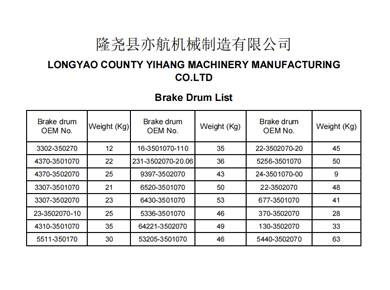Aug . 06, 2024 09:41 Back to list
Innovative Solutions for Efficient E-Rickshaw Brake Drum Design and Performance Enhancement
The Importance of Brake Drums in E-Rickshaws
E-rickshaws, also known as electric rickshaws, have emerged as a popular mode of transportation in urban and semi-urban areas across many countries. They offer a sustainable and eco-friendly alternative to traditional vehicles, reducing the carbon footprint and contributing to cleaner air. However, as with any vehicle, the safety and efficiency of e-rickshaws heavily depend on their braking systems. One crucial component of this system is the brake drum, which plays a vital role in ensuring the vehicle stops effectively and safely.
What is a Brake Drum?
A brake drum is a cylindrical component that forms part of the drum brake system in vehicles. It works in conjunction with brake shoes to create friction when the brakes are applied. When the brake pedal is pressed, hydraulic fluid is sent to the brake shoes, which then expand against the inner surface of the drum, generating the friction needed to slow down and stop the vehicle. In e-rickshaws, brake drums are often preferred for their simplicity and effectiveness, especially given the vehicle's lower speed and weight compared to heavier automobiles.
Advantages of Brake Drums in E-Rickshaws
1. Cost-Effective One significant advantage of brake drums is their affordability. For electric rickshaw manufacturers and operators, minimizing maintenance costs is crucial. Brake drums are generally cheaper to produce and replace than disc brakes, making them more viable for mass production and service.
2. Durability Brake drums are known for their durability. They have a larger surface area compared to disc brakes, which means they can better absorb and dissipate heat generated during braking. This characteristic makes them suitable for applications where frequent braking is necessary, such as in urban settings with heavy traffic.
e rickshaw brake drum

3. Simplified Maintenance The maintenance of brake drum systems is often less complicated than that of disc brake systems. This simplicity leads to lower labor costs during service and repairs. E-rickshaw operators benefit from a straightforward inspection and replacement process, ensuring that their vehicles are always safe to operate.
4. Consistent Performance Brake drums generally provide consistent performance in various weather conditions. Unlike disc brakes, which can experience a reduction in braking effectiveness when wet, brake drums tend to perform reliably regardless of environmental factors. This reliability is critical in ensuring the safety of passengers and the driver alike.
Challenges and Considerations
Despite their advantages, there are challenges associated with brake drums that need consideration. Over time, brake drums can wear out, leading to reduced braking efficiency and necessitating timely inspections and replacements. Additionally, excessive heat can cause brake fade, where the braking power diminishes due to overheated components. To mitigate these issues, e-rickshaw manufacturers must ensure that quality materials are used and that proper engineering techniques are followed.
Furthermore, as e-rickshaws become more prevalent, there is a growing demand for better braking technology. Manufacturers are exploring alternatives such as regenerative braking systems, which not only enhance safety but also increase energy efficiency by using the energy generated during braking to recharge the vehicle's battery.
Conclusion
In conclusion, the brake drum is a crucial component of the braking system in e-rickshaws, contributing significantly to their overall safety and performance. While they offer several advantages, including cost-effectiveness and durability, it is essential for operators to stay vigilant regarding maintenance and potential upgrades as technology evolves. As the e-rickshaw industry continues to grow, focusing on the braking systems will be vital to ensuring secure transport solutions that meet the demands of urban mobility. Adopting best practices in maintenance and considering advancements in braking technology will further enhance the reliability and safety of e-rickshaws on the road.
-
Scania Brake Drums: OEM Quality for Optimal Safety & Durability
NewsAug.16,2025
-
R.V.I: Advanced Remote Visual Inspection for Precision
NewsAug.15,2025
-
Discover HYUNDA: Innovative Vehicles, Equipment & Solutions
NewsAug.14,2025
-
R.V.I: Unlock Advanced Insights & Real-time Performance
NewsAug.13,2025
-
Kamaz Brake Drum: Durable & Reliable for Heavy Duty Trucks
NewsAug.12,2025
-
Heavy Duty Iveco Brake Drum - Premium Quality & Safety
NewsAug.11,2025
